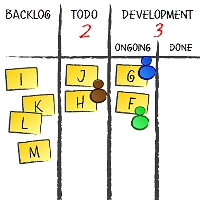I discuss different Kanban boards or task boards with their teams pretty often. It’s not uncommon for me to see a board of a team that I know nothing of. I like these moments. I typically challenge myself to make sense out the visualization as I stare at it.
Some parts are rather obvious. Typically the process isn’t that difficult to figure out. Usually I can tell who is working on what at a glance too. On the other hand something that should be obvious, but often isn’t, are classes of service – what they are and which items are of which class. And then there are lots of small different artifacts like blockers, comments, subtasks and what have you. Those do require some additional explanations.
One of common sins of teams adopting Kanban is making visualization too complex. We do say visualize everything, but obviously it means “as long as it adds value.” Boards tend to get more and more complex over time as we typically want to track more information as we understand better how the work gets done. We really don’t need to complicate things more than necessary on the day one.
So what makes a board a good one? The board is good when it does its job as an information radiator. This happens only when it is easy to comprehend and understand for the team members.
This is a core of my 5-minute test to verify whether the board is designed well. The test is simple.
A random team member should describe what is happening on the board to an outsider – someone who neither is a part of the team nor works with it regularly. If the outsider has any questions about specific things in the board they should ask and get the answers from the team member. The whole activity is time boxed to 5 minutes (thus the name).
The board passes the test if at the end of the task the outsider can tell what exactly is happening in the team: who works on what, what are the problems (if any), what is the progress of work, how the team knows what to do, etc.
One could argue that for bigger, more complex boards 5 minutes is not enough. I don’t agree. When we are interacting with the boards we rarely have more than just a couple of minutes. Of course team members would know part of the design without any explanation. That is why I’m giving an outsider full 5 minutes.
The more stuff there is to take into consideration when making routine, atomic, everyday project decisions the bigger the chance someone would misinterpret part of that. That’s the point where understanding the board, and the process, isn’t fully shared across the team anymore. That’s the point where people start acting differently despite identical input.
This is exactly the problem we tried to address when introducing information radiators in the first place. If the board doesn’t solve that problem it simply doesn’t work.
Would your Kanban or task board pass the 5-minute test?

 Subscribe RSS feed
Subscribe RSS feed